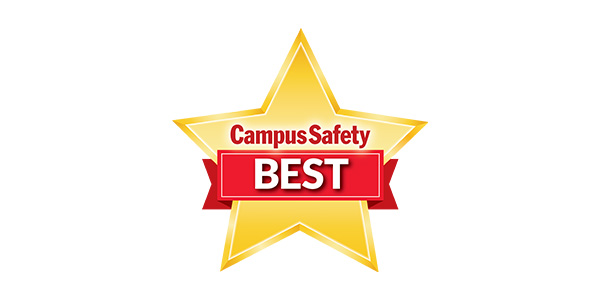There’s nothing like the excitement of game day. The roar of the crowd in the stadium. The grit of opposing teams striving to crush their rivals. The pyrotechnics. The sizzle and smell of burgers and hotdogs wafting from concession grills. Today’s college stadiums are virtual mirror images of professional spectator venues. And as such, their security staff face similar challenges in maintaining a fun and safe fan experience – whether the stadium is hosting a sporting event, a star-studded concert, or other entertainment.
So how do the professional stadiums do it? How do their security teams maintain heightened situational awareness from the parking lot, gates and seating bowl to the field, concourse, and behind-the-scenes operations? They rely on an integrated network of security technology solutions like cameras, radar, audio systems, and analytics to act as a force multiplier.
While many colleges and universities may not have the same technology budget as the pros, with smart deployment of what they can afford, they can achieve similar results. Let’s look at what’s possible.
Cameras Help Keep Stadium Tailgating Under Control
Tailgating parties are often a big part of the game day experience. But passionate rivalry and beer can sometimes start with trash talk and lead to physical altercation. Monitoring pregame festivities with high mounted megapixel fixed dome and high-definition pan/tilt/zoom (PTZ) surveillance cameras can give security a sweeping view of the parking lot and the ability to quickly focus in on problem areas. Dispatching patrol officers equipped with body worn cameras to the scene can help to de-escalate the situation, often turning belligerent fans into angels once they realize they’re being recorded.
Cameras equipped with license plate recognition software can be useful in notifying guest services staff that specially invited VIPs, such as athletic scouts, alumni boosters, and celebrities, have arrived. In addition to VIP alerts, these license plate readers can help with investigations into fender benders and other vehicle liability claims.
Mounting high-volume network speaker horns on parking lot light poles or other structures gives security personnel the ability to make announcements to the crowd – such as a countdown until the gates open, a warning to post-game stragglers that it’s time to exit the parking lot, or in an emergency that help is on the way.
Parking lot cameras equipped with wide dynamic range, lowlight and infrared night vision and perimeter protection analytics like crossline detection can also be useful in alerting security to intruders trying to jump the perimeter fence or enter the stadium after hours. Thermal cameras and a geofence of radar detectors around the perimeter provide another layer of nighttime protection against trespassers and vandals.
Cameras, Analytics, Audio Announcements Improve Game-Day Experience
Bottlenecks are the bane of eager fans. Mounting cameras at the gates can help ease congestion and frustration. Queue monitoring analytics embedded in the cameras can alert security staff members about excessive line lengths so they can notify ticket collectors when to send some of the people in the line to a less crowded gate. Adding network horn speakers at the gates gives security the option to broadcast other gate options or warn unruly fans to desist disorderly behavior.
Ensuring the safety and security of thousands of people inside the stadium requires keeping a watchful eye on everything from audience seats to the concession concourse and retail kiosks, press boxes and VIP suites, to the restricted areas like player locker rooms and employee entrances. To achieve that level of situational awareness, stadiums rely on multi-layered surveillance and security solutions that enable staff to be more proactive in spotting problems and dispatching security details to quickly mitigate them.
For instance, multi-lens cameras – cameras that contain multiple lenses that operate independently – can provide a 360o view of the area from a single IP address. They easily adapt to changing lighting conditions through features like infrared for nighttime illumination, lowlight sensors to enhance images at dusk or in dimly lit locations, and wide dynamic range for capturing sharp images whether in glaring sunlight or dark shadow. Radar-enhanced PTZ cameras provide another way stadiums are reducing camera count without compromising coverage. Unlike traditional PTZ cameras on guard tour – which often leaves the camera pointing in the wrong direction when an incident occurs – the radar senses motion across a wide field of view and automatically redirects the camera to focus on the place where the movement was detected.
Video analytics provide an additional layer of vigilance to the system, helping stadiums compensate for the fact that security staff can’t be everywhere at once. Analytics like object-left-behind and loitering detection can alert security to suspicious packages, vehicles, and people where they shouldn’t be. Smart search features embedded in the video management system allow security to review video from multiple cameras to locate the whereabouts of a missing child, a specific staff member or other person of interest.
While video analytics detect threats the camera sees, stadiums are also employing audio analytics to detect and assess threats that are heard. These analytics are programmed to identify certain sounds like car alarms, glass breaking, and verbal aggression. They’re able to pinpoint the source and automatically direct the camera towards the acoustic event to provide security with a visual context.
To accommodate the many fans taking selfies and texting friends during the game, stadiums are investing in technology to enhance Wi-Fi performance. At the same time, they’re implementing stricter cybersecurity measures like firewalls, digital certificates, and VPNs to prevent hackers from accessing operations data and other systems sharing the network.
Many stadiums are taking advantage of the prevalence of smartphones to enable fans to take an active role in stadium security through a security complaint hotline. Fans can text security if they see or experience a problem. When they report their location security can turn their focus to the cameras in that area, quickly assess the situation, and respond accordingly.
Security Systems Bolster Operations Efficiency
Campus stadiums can also take a lesson from their professional counterparts when it comes to using their intelligent network security systems to protect and improve other areas of their operations beyond the stadium bowl. For instance:
- In the concession areas, even though most food and merchandise kiosks are now going cashless, cameras still have a role in detecting pilfering and unsanctioned giveaways. Like at the gate, analytics and horn speakers can be used to monitor queues, address long line issues in real time, and get fans back in their seats faster so they don’t miss that epic play everyone will be talking about the next day.
- Bathroom sanitation is another area where cameras can help improve the fan experience. Stadiums now place cameras equipped with people counting analytics outside bathrooms to estimate facility usage and alert custodial staff when a location needs refreshing.
- Network cameras deployed at loading docks to monitor deliveries help stadium managers reconcile discrepancies between invoices and actual merchandise received. Additionally, cameras placed in the kitchens help food service managers ensure staff is following proper health and safety protocols when handling and preparing food.
Integration Helps Stadiums Coordinate with Local First Responders
Building their security system on an open standards platform gives stadiums the flexibility to integrate new devices and software from multiple sources to suit their needs. This architecture also helps to streamline communications with other open standards systems in the network.
The security operations center can share important data with other open standards systems within the operation as well as stream critical video and audio situational awareness in real-time with local law enforcement and first responders in case of a threat or medical emergency. For collegiate venues, this could extend to sharing situational awareness with other departments, such as housing, facilities management, and public safety should the stadium security system detect threats or problems that might impact other areas of the campus.
Footage Can Be Used in Security Staff Training
In addition to real-time situational awareness for safety, security, and operations, stadiums are using their surveillance footage to train new staff as well as evaluate and improve the performance of seasoned employees. Watching oneself in action, or observing how one’s peers do the job right, can be a valuable learning experience whether the employee is a security officer, parking attendant, ticket collector, food vendor, customer service personnel, or other staff member.
Because of the complexity of stadium operations, it takes a village to stay ahead of the changing threat landscape. That’s why most professional stadium security managers participate in professional associations like the National Center for Spectator Sports and Safety (NCS4) and the Innovation Institute for the Fan Experience (IIFX). These organizations, which are open to collegiate stadium operators as well, provide a wealth of resources and learning opportunities about the latest advances in stadium security solutions and industry best practices for running a safe and fun operation.
Robert Muehlbauer is a Senior Manager of Business Development for Axis Communications.







